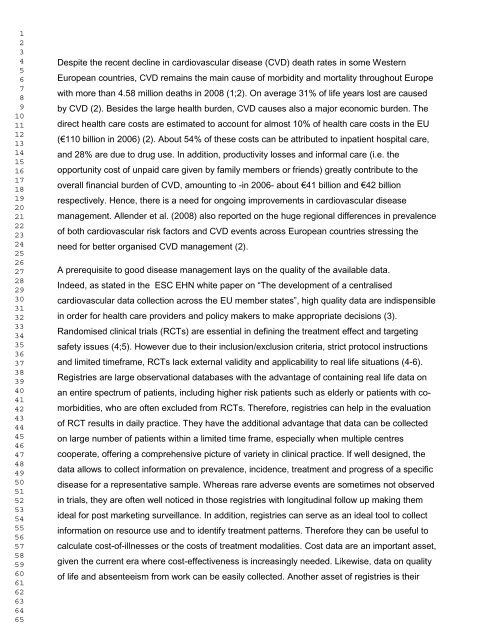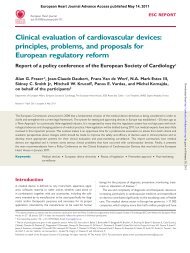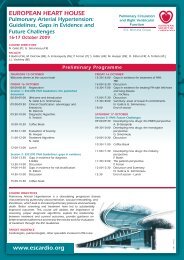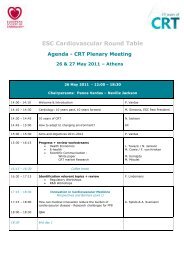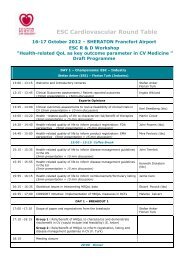Editorial - Cardiovascular Round Table (CRT)
Editorial - Cardiovascular Round Table (CRT)
Editorial - Cardiovascular Round Table (CRT)
Create successful ePaper yourself
Turn your PDF publications into a flip-book with our unique Google optimized e-Paper software.
1234567891011121314151617181920212223242526272829303132333435363738394041424344454647484950515253545556575859606162636465Despite the recent decline in cardiovascular disease (CVD) death rates in some WesternEuropean countries, CVD remains the main cause of morbidity and mortality throughout Europewith more than 4.58 million deaths in 2008 (1;2). On average 31% of life years lost are causedby CVD (2). Besides the large health burden, CVD causes also a major economic burden. Thedirect health care costs are estimated to account for almost 10% of health care costs in the EU(€110 billion in 2006) (2). About 54% of these costs can be attributed to inpatient hospital care,and 28% are due to drug use. In addition, productivity losses and informal care (i.e. theopportunity cost of unpaid care given by family members or friends) greatly contribute to theoverall financial burden of CVD, amounting to -in 2006- about €41 billion and €42 billionrespectively. Hence, there is a need for ongoing improvements in cardiovascular diseasemanagement. Allender et al. (2008) also reported on the huge regional differences in prevalenceof both cardiovascular risk factors and CVD events across European countries stressing theneed for better organised CVD management (2).A prerequisite to good disease management lays on the quality of the available data.Indeed, as stated in the ESC EHN white paper on “The development of a centralisedcardiovascular data collection across the EU member states”, high quality data are indispensiblein order for health care providers and policy makers to make appropriate decisions (3).Randomised clinical trials (RCTs) are essential in defining the treatment effect and targetingsafety issues (4;5). However due to their inclusion/exclusion criteria, strict protocol instructionsand limited timeframe, RCTs lack external validity and applicability to real life situations (4-6).Registries are large observational databases with the advantage of containing real life data onan entire spectrum of patients, including higher risk patients such as elderly or patients with comorbidities,who are often excluded from RCTs. Therefore, registries can help in the evaluationof RCT results in daily practice. They have the additional advantage that data can be collectedon large number of patients within a limited time frame, especially when multiple centrescooperate, offering a comprehensive picture of variety in clinical practice. If well designed, thedata allows to collect information on prevalence, incidence, treatment and progress of a specificdisease for a representative sample. Whereas rare adverse events are sometimes not observedin trials, they are often well noticed in those registries with longitudinal follow up making themideal for post marketing surveillance. In addition, registries can serve as an ideal tool to collectinformation on resource use and to identify treatment patterns. Therefore they can be useful tocalculate cost-of-illnesses or the costs of treatment modalities. Cost data are an important asset,given the current era where cost-effectiveness is increasingly needed. Likewise, data on qualityof life and absenteeism from work can be easily collected. Another asset of registries is their


